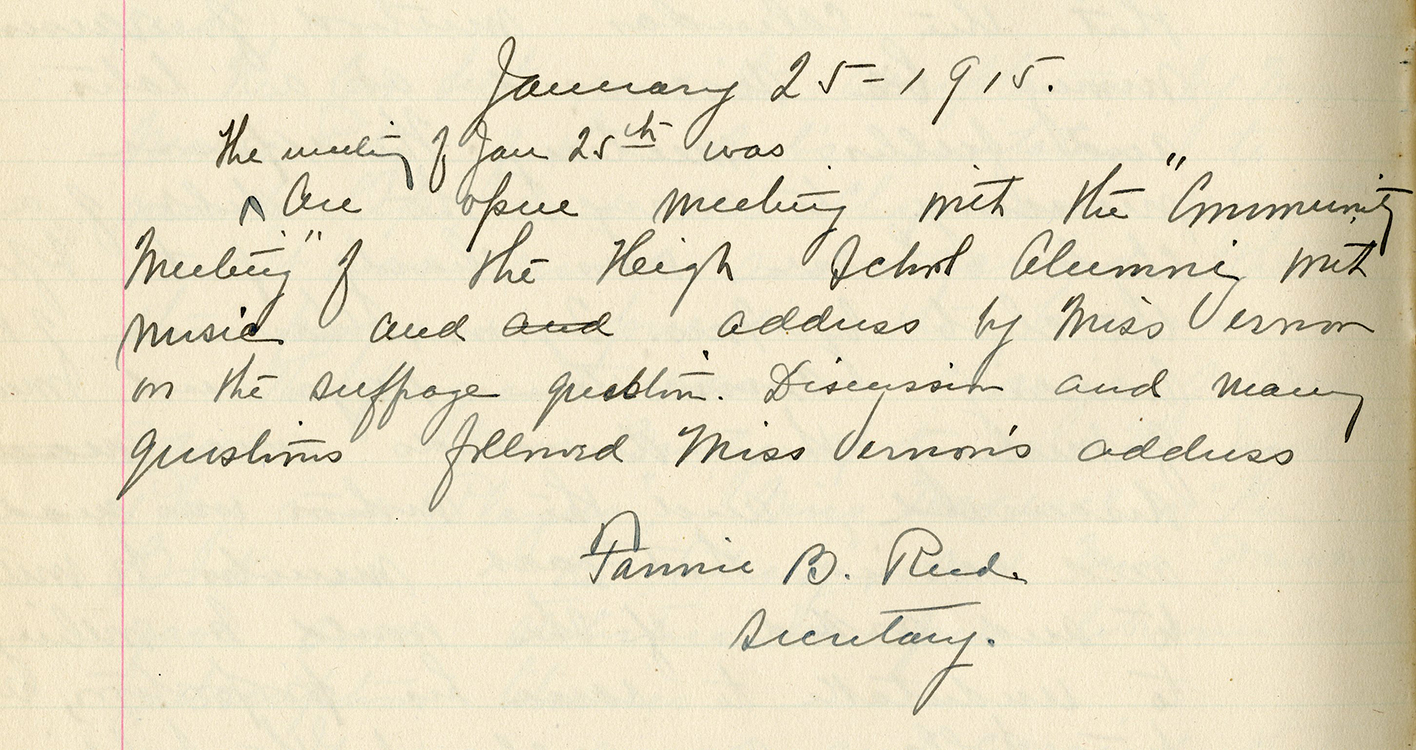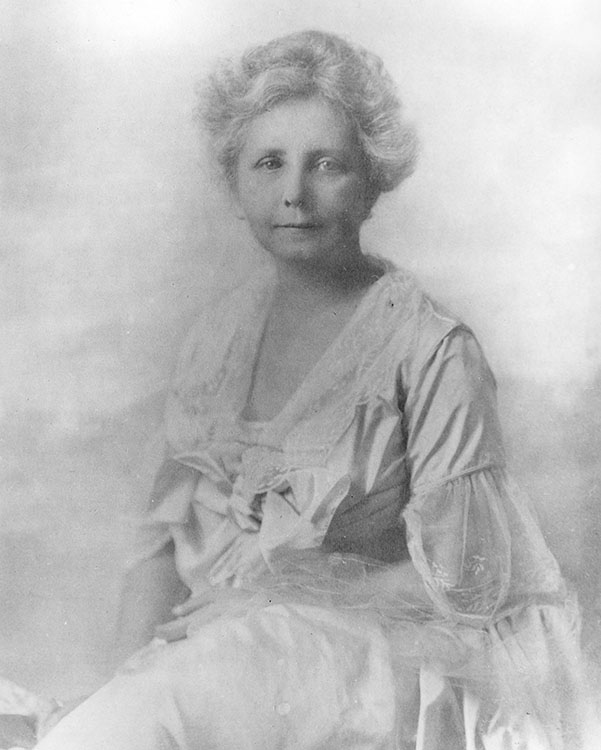WILMINGTON'S MABEL VERNON (1883-1975) - After graduation from Swarthmore College (where she first met suffrage activist Alice Paul) and a teaching stint in Pennsylvania, Mabel Vernon returned to her hometown in 1913 as a full-time suffrage organizer. During mobilizing tours around Delaware, Vernon regularly gave suffrage talks. The minutes of the Newark New Century Club recorded her appearance in January 1915, which provoked “discussion and many questions.”
Vernon became well-known in Delaware for introducing new suffrage ideas and tactics, such as open-air rallies and speeches. She soon moved on to become a national organizer for the Congressional Union (CU) and the National Woman’s Party (NWP), including a stint in Nevada in 1914. During the effort to win passage of the 19th Amendment, Vernon, as Secretary of the NWP in Washington, D.C., organized creative protests, such as the “Silent Sentinel” pickets the White House. Inspired by Alice Paul’s English-influenced suffrage activism, Vernon led Delaware’s NWP members in those and other attention-getting activities.
- Miss Mabel Vernon, National Secretary, National Woman’s Party (photograph), circa 1917. Records of the National Woman’s Party. Facsimile image courtesy of Library of Congress.
- Newark New Century Club Minutes, January 25, 1915. The New Century Club, Newark, Delaware, Yearbook, 1914-1915. Records of the New Century Club of Newark, Delaware.
CATHERINE THORNTON BOYLE (1879-1955) - Born into a working-class Irish Catholic immigrant family, Catherine Boyle became a militant suffragist in 1915 and thereafter a lifelong devotee of the National Woman’s Party (NWP). A munitions worker at the Bethlehem Steel plant in New Castle during World War I, Boyle joined other NWP members from Delaware in the January 1919 “Watchfire of Freedom” protests, burning Woodrow Wilson’s words in an urn outside the White House. Arrested, she served five days in jail. In deciding to have this formal studio portrait taken while holding a tri-color suffrage flag, Boyle proudly declared her allegiance to the NWP.
- A.N. Sanborn, Wilmington, Del. Mrs. Catherine Boyle, 908 Young Street, New Castle, Del. (photograph), circa 1910-1920. Records of the National Woman’s Party. Facsimile image courtesy of Library of Congress.
PUBLIC ADVOCACY - A week after Wilmington's first suffrage parade, this group photograph was taken on the city's train platform, showing individuals from several Delaware suffrage associations headed to Washington, D.C., for a national event. The visual unity of the all-white group, many wearing white suffrage-themed outfits, belied the class and ideological divisions that were emerging among them. Florence Bayard Hilles (center, sporting a sash and feathered hat and holding an American flag) and the petite Mary de Vou (front, center right, holding a pennant), although from similarly privileged backgrounds, would soon come into conflict over strategy and tactics. Three working-class women joined Hilles as suffrage militants: Annie Melvin Arniel (front left, holding Wilmington and Delaware pennants), Agnes Keehan Yerger (second from right, holding Delaware pennant) and Annie Stirlith McGee (front right). Also present (back row) were representatives from the Arden community: Frank and Elenor Stephens, and Frank’s son Donald Stephens.
- Photograph of group at train station, departing from Wilmington, Delaware, to attend suffrage parade in Washington, D.C., 1914. (Wilmington) Sunday Morning Star, May 10, 1914. Facsimile image courtesy of the Delaware Historical Society.
MABEL LLOYD FISHER RIDGELY (1872-1962) - Mabel Ridgely served as president of the Delaware Equal Suffrage Association (DESA) during the campaign to persuade the General Assembly to ratify the 19th Amendment, 1919-1920. With her distinguished family lineage, experience in chairing the highly successful work of the Delaware Women’s Liberty Loan Committee during the Great War, and a residence on Dover’s Green that gave her ready access to buttonholing legislators, Ridgely was well-positioned to lead the ratification effort. She later became the first president of the Delaware League of Women Voters.
The only extant minute-book of the Delaware Equal Suffrage Association (DESA) chronicled the rift in its ranks between the mainstream suffragists and the militants, the activities of members during the Great War, and the organization’s renewed energy and purpose under Eva Halpern Robin’s leadership. As president during the ratification struggle, Mabel Lloyd Ridgely preserved the group’s history by saving the minute-book and donating it to the Delaware Public Archives.
As the Great War came to an end, DESA adopted a forthright resolution indicating its post-war direction, as noted in the October 1918 minutes:
We protest, in the name of the women war workers of the world, and the home makers as well, at the further use of sex as the determining factor in the making of citizens. We place ourselves on record, and we regard our position as unassailable, as enunciating no new truth when we allege that fitness alone should determine our voting population. In the name of the women workers of Delaware, we assert that we desire no longer to be represented by proxy at the ballot box, but we wish to express, unfettered by any assumptions of masculine superiority, our own political convictions at the polls.
- Portrait of Mabel Lloyd Ridgely, circa 1925. Facsimile image courtesy of the Delaware Public Archives.
- “Equal Suffrage” in Delaware, 1916-1919 (original minutes of meetings of Delaware Association) / League of Women Voters, Delaware, 1920-1921 : records and papers of Mabel L. Ridgely. Mabel Lloyd Ridgely papers. Facsimile images courtesy of Delaware Public Archives.
- Delaware Equal Suffrage Association. “We protest in the name of the Women War Workers …” excerpt from Minutes, October 28, 1918. Mabel Lloyd Ridgely papers. Facsimile images courtesy of Delaware Public Archives.

![Miss Mabel Vernon, National Secretary, National Woman’s Party [photograph], circa 1917. Records of the National Woman’s Party Facsimile image courtesy of Library of Congress Miss Mabel Vernon, National Secretary, National Woman’s Party [photograph], circa 1917. Records of the National Woman’s Party Facsimile image courtesy of Library of Congress](https://exhibitions.lib.udel.edu/votes-for-delaware-women/wp-content/uploads/sites/96/2020/04/Miss-Mabel-Vernon.jpg)
![A.N. Sanborn, Wilmington, Del. Mrs. Catherine Boyle, 908 Young Street, New Castle, Del. [photograph], circa 1910-1920. Records of the National Woman’s Party Facsimile image courtesy of Library of Congress A.N. Sanborn, Wilmington, Del. Mrs. Catherine Boyle, 908 Young Street, New Castle, Del. [photograph], circa 1910-1920. Records of the National Woman’s Party Facsimile image courtesy of Library of Congress](https://exhibitions.lib.udel.edu/votes-for-delaware-women/wp-content/uploads/sites/96/2020/04/Catherine_Boyle.jpg)

![Photograph of group at train station, departing from Wilmington, Delaware, to attend suffrage parade in Washington, D.C., 1914. Wilmington, Delaware [Delmarva] Sunday Morning Star, May 10, 1914. Fascimile image courtesy of the Delaware Historical Society Photograph of group at train station, departing from Wilmington, Delaware, to attend suffrage parade in Washington, D.C., 1914. Wilmington, Delaware [Delmarva] Sunday Morning Star, May 10, 1914. Fascimile image courtesy of the Delaware Historical Society](https://exhibitions.lib.udel.edu/votes-for-delaware-women/wp-content/uploads/sites/96/2020/04/Delaware-suffragists-at-Wilmington-train-station_5-9-1914.jpg)

![“Equal Suffrage” in Delaware, 1916-1919 (original minutes of meetings of Delaware Association) / League of Women Voters, Delaware, 1920-1921 : records and papers of Mabel L. Ridgely [cover] Facsimile images courtesy of Delaware Public Archives “Equal Suffrage” in Delaware, 1916-1919 (original minutes of meetings of Delaware Association) / League of Women Voters, Delaware, 1920-1921 : records and papers of Mabel L. Ridgely [cover] Facsimile images courtesy of Delaware Public Archives](https://exhibitions.lib.udel.edu/votes-for-delaware-women/wp-content/uploads/sites/96/2020/04/9200-R09-002_equal_suffrage_association_of_DE_minute_book_1916_1919.jpg)
